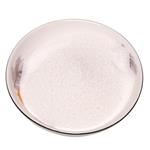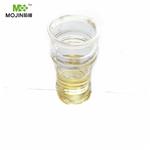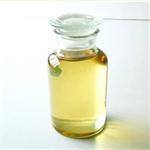Sodium hypochlorite
- CAS No.
- 7681-52-9
- Chemical Name:
- Sodium hypochlorite
- Synonyms
- naocl;Sodium hypochlorite solution;HYPOCHLORITE;clorox;ANTIFORMIN;chlorox;Chlorine liquid;aabb;cilvsuanan;LIQUID CHLORINE
- CBNumber:
- CB1705333
- Molecular Formula:
- ClNaO
- Molecular Weight:
- 74.44
- MDL Number:
- MFCD00011120
- MOL File:
- 7681-52-9.mol
- MSDS File:
- SDS
| Melting point | -16 °C |
|---|---|
| Boiling point | 111 °C |
| Density | 1.25 g/mL at 20 °C |
| vapor pressure | 17.5 mmHg ( 20 °C) |
| refractive index | 1.3870 |
| storage temp. | 2-8°C |
| solubility | Methanol (Slightly), Water (Slightly) |
| form | Solution |
| color | Light yellow |
| Specific Gravity | 1.209 |
| Odor | pale greenish to yel. liq., chlorine bleach odor |
| Water Solubility | decomposes. |
| Merck | 14,8628 |
| Exposure limits |
ACGIH: Ceiling 2 mg/m3 OSHA: TWA 2 mg/m3 NIOSH: IDLH 10 mg/m3; Ceiling 2 mg/m3 |
| Dielectric constant | 6.7(Ambient) |
| BCS Class | 1 |
| Stability | Stable. Contact with acids releases poisonous gas ( chlorine ). Light sensitive. Incompatible with strong acids, amines, ammonia, ammonium salts, reducing agents, metals, aziridine, methanol, formic acid, phenylacetonitrile. |
| LogP | -3.42 at 20℃ |
| CAS DataBase Reference | 7681-52-9(CAS DataBase Reference) |
| Substances Added to Food (formerly EAFUS) | SODIUM HYPOCHLORITE |
| FDA 21 CFR | 173.315; 175.105; 176.170; 177.2800 |
| EWG's Food Scores | 3 |
| FDA UNII | DY38VHM5OD |
| NCI Drug Dictionary | Dakin's solution |
| ATC code | D08AX07 |
| Pesticides Freedom of Information Act (FOIA) | Sodium hypochlorite |
| EPA Substance Registry System | Sodium hypochlorite (7681-52-9) |
SAFETY
Risk and Safety Statements
| Symbol(GHS) |   GHS05,GHS09 |
|||||||||
|---|---|---|---|---|---|---|---|---|---|---|
| Signal word | Danger | |||||||||
| Hazard statements | H314-H410 | |||||||||
| Precautionary statements | P273-P280-P303+P361+P353-P304+P340+P310-P305+P351+P338-P363 | |||||||||
| Hazard Codes | C,Xi,N | |||||||||
| Risk Statements | 31-34-36/38-36/37/38-50 | |||||||||
| Safety Statements | 26-36/37/39-45-50A-28A-36-61-50-28 | |||||||||
| RIDADR | UN 1791 8/PG 3 | |||||||||
| WGK Germany | 2 | |||||||||
| RTECS | NH3486300 | |||||||||
| TSCA | Yes | |||||||||
| HazardClass | 8 | |||||||||
| PackingGroup | III | |||||||||
| HS Code | 28289000 | |||||||||
| Toxicity | Skin contact with the solid hypochlorite pentahydrate or its concentrated solution can cause irritation. Ingestion may cause corrosion of mucous membranes and gastric perforation. | |||||||||
| NFPA 704 |
|
Sodium hypochlorite price More Price(26)
| Manufacturer | Product number | Product description | CAS number | Packaging | Price | Updated | Buy |
|---|---|---|---|---|---|---|---|
| Sigma-Aldrich | 13440 | Sodium hypochlorite solution 6-14% active chlorine basis | 7681-52-9 | 500mL | $98.5 | 2024-03-01 | Buy |
| Sigma-Aldrich | 13440 | Sodium hypochlorite solution 6-14% active chlorine basis | 7681-52-9 | 6x500mL | $344 | 2024-03-01 | Buy |
| Alfa Aesar | 033369 | Sodium hypochlorite, 11-15% available chlorine | 7681-52-9 | 500g | $63.9 | 2024-03-01 | Buy |
| Alfa Aesar | 033369 | Sodium hypochlorite, 11-15% available chlorine | 7681-52-9 | 10kg | $161 | 2024-03-01 | Buy |
| Sigma-Aldrich | 425044 | Sodium hypochlorite solution reagent grade, available chlorine 10-15% | 7681-52-9 | 250ml | $61.2 | 2024-03-01 | Buy |
Sodium hypochlorite Chemical Properties,Uses,Production
Chemical Properties
Sodium hypochlorite, NaOCl, is an air-unstable,pale green crystalline solid that is soluble in cold water, decomposes in hot water, and has a sweet aroma. It generally is available in one of two strengths. The household liquid bleach contains about 5.25 wt% NaCIO. The commercial product(sometimes called 15% bleach) contains 150g/L available chlorine. This is equivalent to about 13 wt% sodium hypochlorite. Sodium hypochlorite is used as a bleaching agent for paper pulp and textiles, as an oxidizing reagent, as a disinfectant, as a chemical intermediate,and in medicines.
The hypochlorite ion (OCI-) is similar to wet chlorine gas in its effects on materials. Not many metals exhibit good resistance even at low temperatures and concentrations. Because hypochlorite solutions are unstable at neutral and lower pHs,they normally contain excess alkali,which modifies the aggressiveness somewhat.
Physical properties
Anhydrous sodium hypochlorite explodes; the pentahydrate is a pale-green crystalline solid; orthorhombic structure; density 1.6 g/cm3; melts at 18°C; decomposed by CO2 in the air; soluble in water, 29.3 g/100 mL at 0°C; the aqueous solution is highly stable.
History
Sodium hypochlorite exists as an aqueous solution from 5 15% NaOCl and is commonly called bleach. Household bleach is typically a 5.25% solution, and industrial bleach is sold as a 12% solution. When sodium hypochlorite is used in this entry, it is assumed to be the aqueous solution, which is clear, slightly yellow, corrosive, and has a distinctive chlorine smell. Chorine gas was discovered by Carl Wilhelm Scheele (1742 1786) in 1774 and known initially as depholgisticated salt spirit. In 1787, the French chemist Claude Louis Berthollet (1749 1822) experimented with aqueous solution of chlorine gas as bleaching agents. Based on Berthollet's work, the Javel Company located on the outskirts of Paris began to produce bleaches in 1788. Chlorine gas was dissolved in a solution of soda potash (potassium carbonate) to obtain a product called liqueur de Javel, which was potassium hypochlorite. Potash treated with chlorine gas was also used to produce bleaching powders. In 1820, Antoine Germaine Labarraque (1777 1850), an apothecary, substituted cheaper soda ash (sodium carbonate) for potash to produce Eau de Labarraque or Labarraque solution, which was sodium hypochlorite. Eau de Labarraque was used as a disinfectant and to bleach paper. Bleaching powders, borax, lye, and blueing were used as bleaches throughout the 19th century.
Sodium hypochlorite is the primary hypochlorite used as a bleach and disinfectant,
accounting for 83% of world hypochlorite use, with calcium hypochlorite accounting for
the remaining 17%. Approximately 1 million tons of sodium hypochlorite was used globally
in 2005, with about half this amount used in households for laundry bleaching and
disinfection. The other half was used primarily for wastewater and drinking water treatment;
other uses include pool sanitation, bleaching of pulp, paper, and textiles, and as an industrial
chemical.
Uses
Sodium hypochlorite is marketed only as an aqueous solution because the anhydrous solid is highly unstable and can explode. The solid pentahydrate also is unstable in air, decomposed by reaction with carbon dioxide from air. Aqueous solutions are very stable. They are used for bleaching textiles and paper pulp; in cleaning solutions; in water purification; as a disinfectant for swimming pools; and as a germicide and topical antiinfective. The hypochlorite also is used as an oxidizing agent in many preparative reactions. It is an ingredient of commercial bleaching products such as Clorox and Dazzle.
Uses
NaOCl is a strong oxidizer used in swimming pools, and when diluted to 5.25%, it is known as the laundry bleach Clorox.
Preparation
Sodium hypochlorite solution is obtained by passing chlorine into sodium hydroxide solution. The pentahydrate is obtained by crystallization.
Definition
ChEBI: An inorganic sodium salt in which hypochlorite is the counterion.
General Description
Green to yellow watery liquid with an odor of bleaching liquid odor. Sinks and mixes with water.
Air & Water Reactions
Water soluble. Decomposes into chlorine and oxygen gases in hot water.
Reactivity Profile
Salts of hypochlorous acid, HClO. Generally toxic, irritants and powerful oxidizers, particularly in the presence of water at higher temperature as they decompose to release oxygen and chlorine gases. On contact with urea they form the highly explosive NCl3 . When heated or on contact with acids, they produce highly toxic fumes of chlorine gas [Sax, 9th ed., 1996, p. 1905]. Can react with sulfuric acid to produce heat and chlorine gas.
Hazard
Fire risk in contact with organic materials. Toxic by ingestion, strong irritant to tissue.
Health Hazard
Liquid can be irritating to skin and eyes if contact is maintained.
Fire Hazard
Behavior in Fire: May decompose, generating irritating chlorine gas.
Flammability and Explosibility
Non flammable
Side effects
Sodium hypochlorite, commonly known as bleach, may be used as a disinfectant solution. It is a strong irritant; however, isolated reports of CoU to sodium hypochlorite exist. The mechanism for the Cou is uncertain.
Hostynek et al. describe a 36-year-old woman who developed an intensely pruritic maculopapular rash to a hypochlorite-containing cleaning product that she spilled on her leg. The rash progressed to involve her trunk and extremities and was associated with teary eyes, dyspnea, and facial edema. There was a history of a previous sensitizing event, and open testing to 1% sodium hypochlorite produced an immediate urticarial reaction. The authors suggest that this could be due to an immunological mechanism given the generalized symptoms; however, no confirmatory testing was performed and the potential of sodium hypochlorite to cause nonimmunologic Cou was evident with four of 10 controls experiencing a wheal-and-flare reaction to open application of 6% sodium hypochlorite.
Caliskan et al. described a 32-year-old female who developed severe lip edema and breathing difficulty after using a sodium hypochlorite irrigation during endodontic treatment. A scratch test to sodium hypochlorite resulted in immediate erythema and edema that began to extend up the patient’s arm. She also had a history of breathing difficulties and had developed dermatitis from her hands to elbows with the use of household cleaning agents.
Neering reported on a patient who had experienced intermittent Cou to chlorinated pools and contact with a cleansing agent containing sodium hypochlorite. A scratch test to chlorinated water was strongly positive in this patient, but negative in five controls, and closed patch testing to sodium hypochlorite was strongly positive at three hours.
Safety Profile
Mddly toxic by ingestion. Human systemic effects by ingestion: somnolence, blood pressure lowering, corrosive to skin, nausea or vomiting. Human mutation data reported. An eye irritant. Corrosive and irritating by ingestion and inhalation. The anhydrous salt is highly explosive and sensitive to heat or friction. Explosive reaction with formic acid (at So), phenylacetonitrile. Reacts to form explosive products with amines, ammonium salts (e.g., ammonium acetate, (NH4)2CO3, ammonium nitrate, ammonium oxalate, (NH4)3P04), aziridme, methanol. Violent reaction with phenyl acetonitrile, cellulose, ethyleneimine. Solutions in water are storage hazards due to oxygen evolution. When heated to decomposition it emits toxic fumes of NaaO and Cl-. Used as a bleach.
Sodium hypochlorite Preparation Products And Raw materials
Raw materials
Preparation Products
1of8
| Supplier | Tel | Country | ProdList | Advantage | |
|---|---|---|---|---|---|
| Shanghai Bojing Chemical Co.,Ltd. | +86-86-02137122233 +8613795318958 | bj1@bj-chem.com | China | 298 | 55 |
| Henan Tianfu Chemical Co.,Ltd. | +86-0371-55170693 +86-19937530512 | info@tianfuchem.com | China | 21695 | 55 |
| Hangzhou FandaChem Co.,Ltd. | 008657128800458; +8615858145714 | fandachem@gmail.com | China | 9348 | 55 |
| Hefei TNJ Chemical Industry Co.,Ltd. | +86-0551-65418679 +86-18949832763 | info@tnjchem.com | China | 2989 | 55 |
| Shanxi Naipu Import and Export Co.,Ltd | +86-13734021967 +8613734021967 | kaia@neputrading.com | China | 1011 | 58 |
| career henan chemical co | +86-0371-86658258 | sales@coreychem.com | China | 29914 | 58 |
| SHANDONG ZHI SHANG CHEMICAL CO.LTD | +86 18953170293 | sales@sdzschem.com | China | 2931 | 58 |
| Hubei Jusheng Technology Co.,Ltd. | 18871490254 | linda@hubeijusheng.com | CHINA | 28180 | 58 |
| Hebei Guanlang Biotechnology Co., Ltd. | +86-19930503282 | alice@crovellbio.com | China | 8823 | 58 |
| Xiamen AmoyChem Co., Ltd | +86-592-6051114 +8618959220845 | sales@amoychem.com | China | 6387 | 58 |
Related articles
- What happens when you mix bleach and vinegar?
- When this molecule is mixed with the acetic acid in vinegar or other acid types, it releases chlorine gas.
- Mar 12,2024
- Is Sodium Hypochlorite an Acid or Base?
- Sodium hypochlorite solution is a weak base that is inflammable.
- Feb 28,2024
View Lastest Price from Sodium hypochlorite manufacturers
| Image | Update time | Product | Price | Min. Order | Purity | Supply Ability | Manufacturer | |
|---|---|---|---|---|---|---|---|---|
 |
2023-09-04 | sodium hypochlorite
7681-52-9
|
US $0.00-0.00 / kg | 1kg | 99% | 20tons | Hebei Yanxi Chemical Co., Ltd. | |
 |
2023-08-02 | Sodium hypochlorite
7681-52-9
|
US $50.00 / kg | 1kg | 99% | 20tons | Hebei Mojin Biotechnology Co., Ltd | |
 |
2023-07-31 | Sodium hypochlorite
7681-52-9
|
US $1.00 / kg | 20kg | 99.95% | 500tons | Hebei Linwo New Material Technology Co., LTD |
-

- sodium hypochlorite
7681-52-9
- US $0.00-0.00 / kg
- 99%
- Hebei Yanxi Chemical Co., Ltd.
-

- Sodium hypochlorite
7681-52-9
- US $50.00 / kg
- 99%
- Hebei Mojin Biotechnology Co., Ltd
-

- Sodium hypochlorite
7681-52-9
- US $1.00 / kg
- 99.95%
- Hebei Linwo New Material Technology Co., LTD





